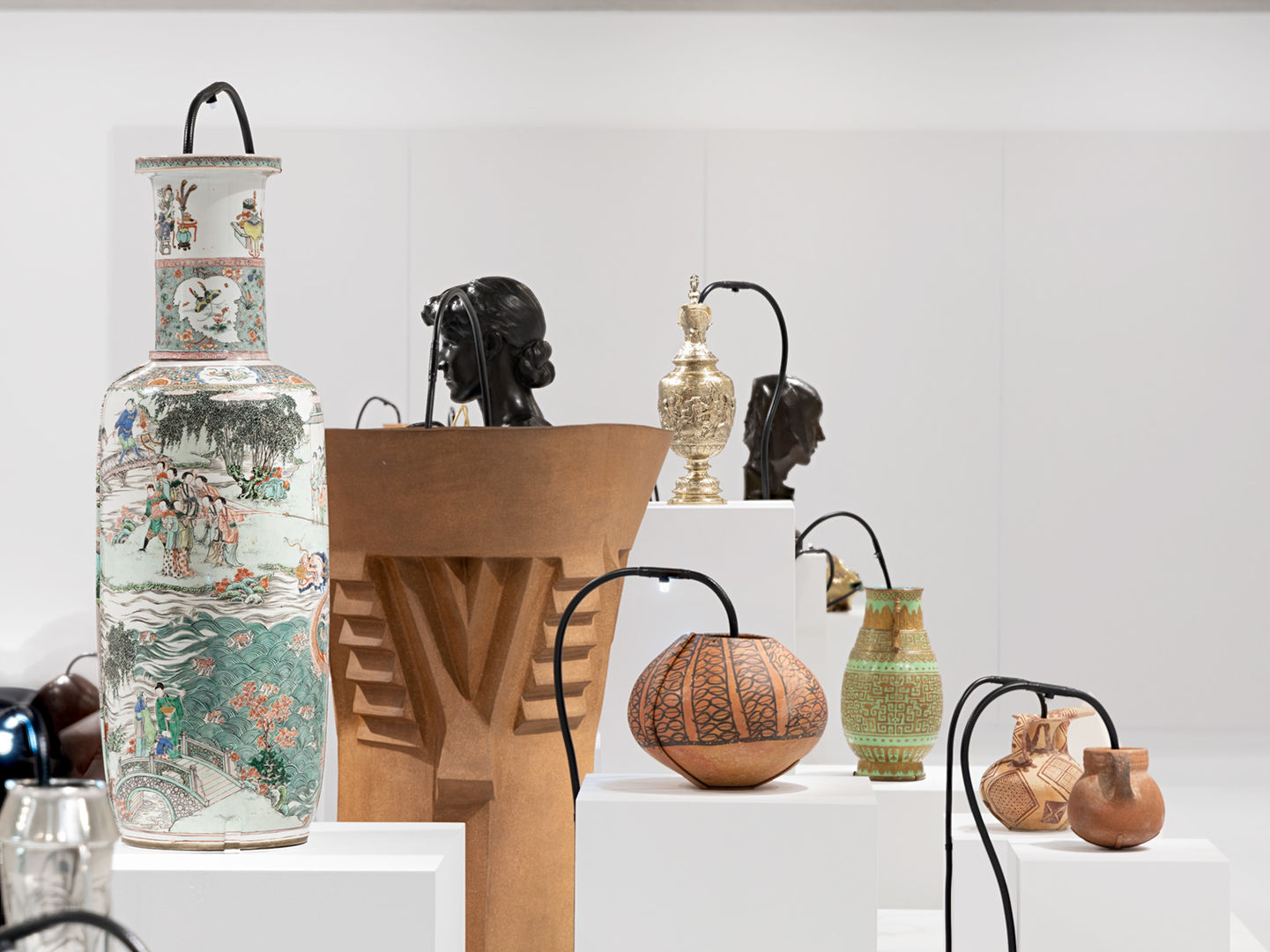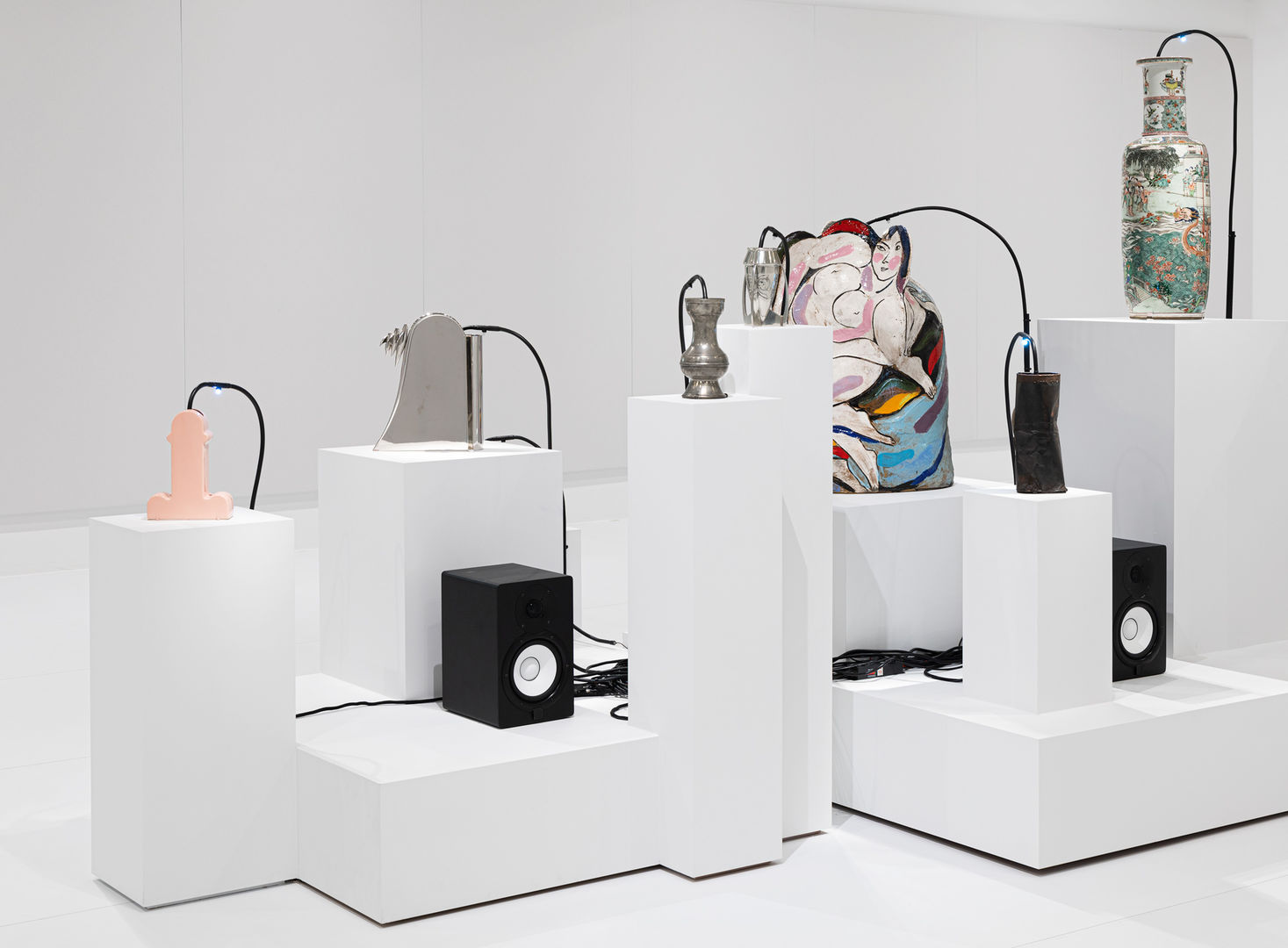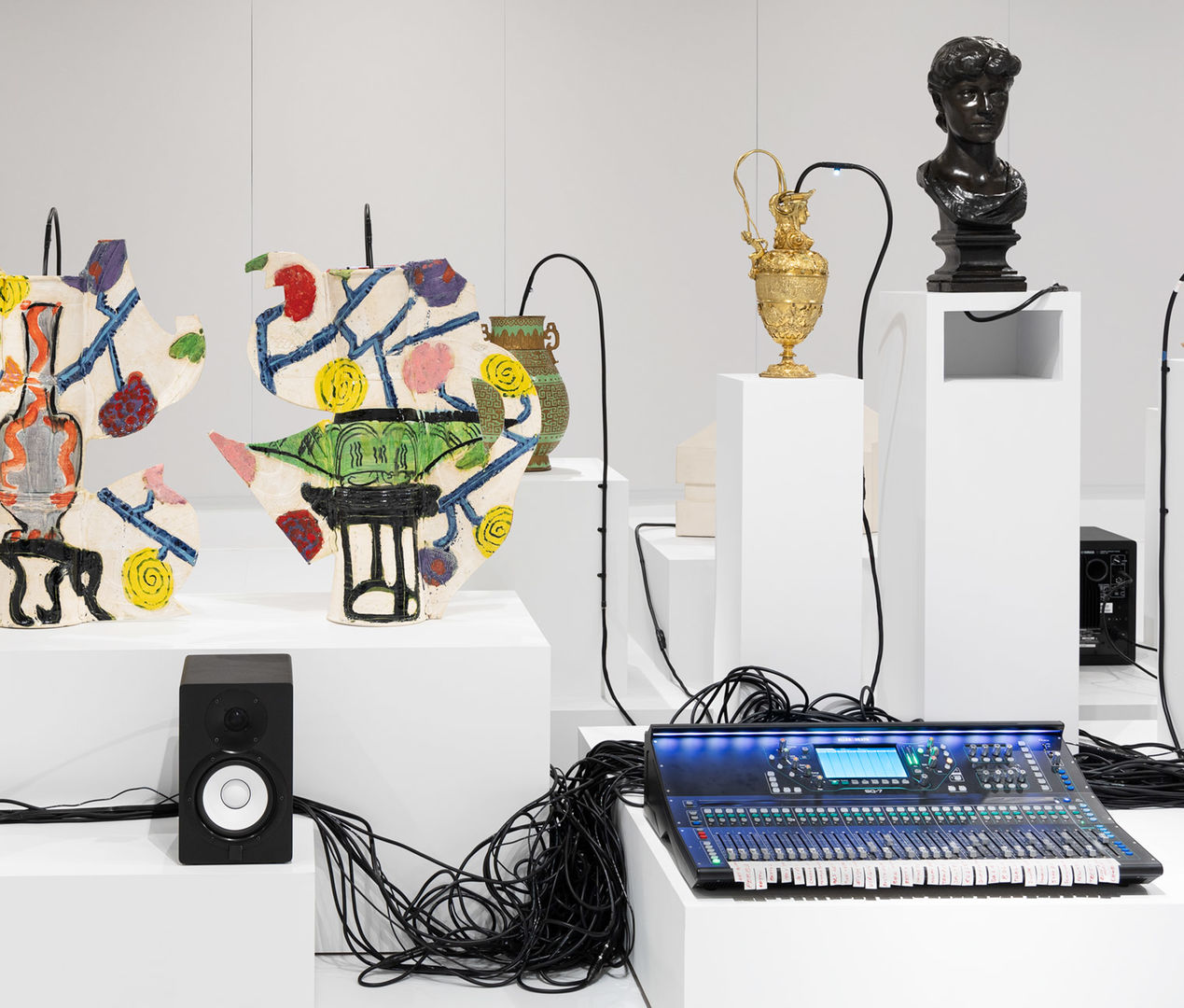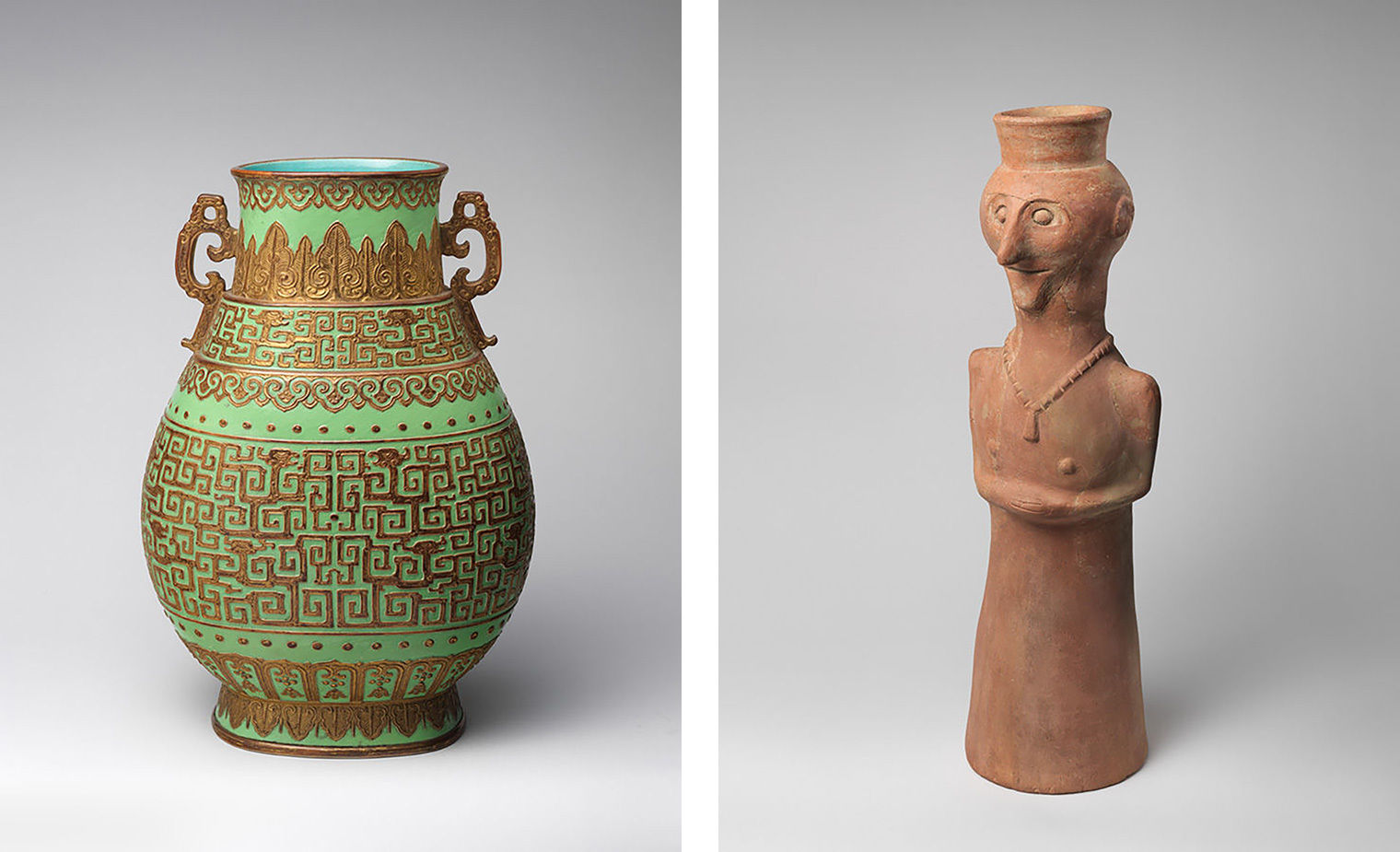British artist Oliver Beer creates sculptures, installations, videos, and immersive live performances that reveal the hidden properties of objects, bodies, and architectural sites. His performance installation at The Met Breuer, Vessel Orchestra, is the first sound-based exhibition commissioned by the Museum, and is on view through August 11, 2019. Here, Lauren Rosati, co-curator of the exhibition, is in conversation with the artist.
Lauren Rosati:
The Vessel Orchestra is an unlikely instrument composed of thirty-two artworks from the Museum's collection. When did you first realize the musical potential of these objects?
Oliver Beer:
I'm a sculptor and have been trained in music, so I've always been very conscious of the musicality of space. I've worked a lot with architectural acoustics, and some of my work has included building spaces that are designed to resonate at particular notes.
A few years ago, around 2015, I realized that the architecture of a vessel was just as musical as the architecture of a building. If you simply amplify the natural resonance of a hollow object, it enters into a very gentle feedback loop. I started collecting objects from my own life that were in harmony with each other. I made a portrait of my grandmother from humble objects—like her chamber pot, which sings a B-flat, and her watering can—as well as beautiful and kitsch decorative objects. That made up an exhibition called Household Gods, which was sort of the distant cousin to Vessel Orchestra. It was an intimate biography of my grandmother and her precise place in history.
Rosati:
The objects in this exhibition are so diverse, and yet their timbre—the quality of their sound—is pure and consistent, regardless of their age or material. How did you reconcile the objects with the tones that they sing?
Beer:
The sound that we're hearing is not the sound of the object itself—it's just the empty space resonating, empty air vibrating. Because of that, the timbre is the same across all the vessels, whether they're made of metal, ceramic, or wood. Each object sings with the same pure sine wave, which means that every artwork has the same musical quality as the next. That allows you to create a sound that is incredibly egalitarian and balanced between objects.

Installation view of Vessel Orchestra
Rosati:
There's something very poetic in the idea that sound is indiscriminate, that these objects spanning thousands of years and representing vastly different cultures share a common element, which you've made perceptible to the audience. Although you've worked with vessels from your own collection in the past, this installation at The Met marks the first time that you've worked with artworks held by a museum. You've moved from an exploration of your personal history to a shared cultural patrimony. Here, you've deployed objects from five curatorial departments: the American Wing, Ancient Near Eastern Art, Asian Art, European Sculpture and Decorative Arts, and Modern and Contemporary. Could you talk about this shift, and what it means for your work?
Beer:
Yes, instead of my personal history, I'm working with a common heritage that we are all being given access to at the Museum. The Met very generously gave me access to go into storage and have this intimate relationship with the collection, hearing these objects that you're normally only able to see. Over a couple of years, I listened to hundreds of objects during our "audition" process.
One thing that's really important to this project is that every vessel sings the same note from the day it's made, forever, because of its geometry and form. For example, the oldest object in the exhibition has been singing a D for 7,000 years, and will still sing a D in 7,000 years' time. The objects become almost autonomous, in that way. I just applied a single musical principle to the collection—the notes on a Western chromatic scale—and that organizing principle identified these pieces.
The objects wouldn't be shown here if they weren't perfectly in tune with each other. And some wouldn't be shown at all, because they're humble or because they're not what we currently consider to be the most important things to look at, aesthetically, culturally, or historically. In that sense, this is an unbiased portrait of the collection.
Rosati:
The audition process raised a lot of questions for me, such as whether or not there is a discernible relationship between an object's volume and its tone, or if listening to an object can inform its cultural value. What was the process like for you? Did you discover anything surprising in the collection during the auditions?
Beer:
It was very long and painstaking. One interesting thing is that I started to hear patterns. Like, there were some notes that recurred more often than others. I kept finding middle E-flats. I started to question why this note keeps recurring across cultures and civilizations. Is it because there's a radius of the human arm that leads us to make works of recurring geometry and volume? Or maybe it's because a vessel that forms a middle E-flat is about the size of a pint, and the human body needs about a pint all the time—you know, water, beer. . . . There are so many patterns to investigate and questions that come up when you start thinking musically about a visual collection.
Rosati:
Indeed, one thing that's really powerful and surprising about your project is the way it opens up those relationships and allows new meanings to emerge, through the juxtaposition of objects that an encyclopedic museum might typically segregate. That's evident not only in the diversity of vessels on view but also in the installation design—we arranged the objects in harmonic groupings rather than by chronology or geography.
Beer:
Yes. I was able to create a kind of ensemble in the round, which disrupts any hierarchies between the objects: Miró, Woodman, Sottsass, unnamed artisans—it's a very unlikely family. Maybe what unites them is that each vessel has its own history of survival. In some cases, this spans hundreds and hundreds of generations; in other cases, the pieces are very recent. But they all have a reason for being here at The Met, and those reasons are bound up in the history and context of the Museum, the narratives it tells about art history.

Installation view of Vessel Orchestra
Rosati:
You mentioned that this portrait of the Museum's collection is an unbiased one, but you selected these objects based on their resonance to the chromatic musical scale, which is of course a kind of bias. And many of these vessels did not originate in a Western context, so pressing them into the service of Western musical principles could be construed as an imperialist or colonialist project. This is something both of us were conscious of in framing the project. How would you respond to that?
Beer:
I chose the well-tempered scale because it's like the lingua franca of music. It allows contemporary musicians from across the globe to interact with this installation, to treat it like an instrument, and to respond to that provocation that you just described. But of course, that is just one possible scale, and if we were to repeat the process with another tuning system then the installation would include different objects.
That's one of the exciting things about the language of music. We are biologically programmed to understand tuning, and to recognize when sounds are mathematically in tune—even if we don't know that's what we're recognizing. Every culture shares fifths and fourths and octaves, going all the way back to the Hurrian Hymn, which is a Babylonian score, the earliest piece of music we have. We can still recognize its harmony today.
And to expand the exhibition's musical context, we've also invited musicians to hold concerts every Friday night during the exhibition.
Rosati:
Right, we collaborated with Limor Tomer, the general manager of MetLiveArts here at the Museum, to program a series of concerts, and invited a group of musicians, from John Zorn to Matana Roberts, to perform on the Vessel Orchestra. Though you've created installations with sonified vessels before, this is the first time you've made them playable as a live performance instrument.
Beer:
Yes. Some of these musicians come from cultures that don't primarily use the Western scale, and some are even working that tension into their concerts, which is really important, because the well-tempered scale is—like any lingua franca—imperialist in nature.
The question of tuning also points to the music's adaptability. Historically, music has been in constant evolution, because of different historical and geopolitical conditions. These questions and possibilities are written into this installation. No music is apolitical.

Installation view of Vessel Orchestra
Rosati:
It has been really energizing to have musicians activate these objects, literally instrumentalizing them. You also wrote a composition specifically for the Vessel Orchestra, which plays on a loop, "player-piano style," throughout the exhibition. How did you write for this unique instrument?
Beer:
I applied a kind of archaeological musical process on my collaborators and myself. My earliest musical memory is my grandmother singing this Scottish song, "Black is the color of my true love's hair." That's not something I can change; it's deeply imprinted in me, almost like a sound I carry with me. And I asked my performance collaborators—Nico Muhly, Hamed Sinno from Mashrou' Leila, Jeff Gavett from Ekmeles, and others—what their earliest musical memories were. It was almost always something from their parents or grandparents. The composition I wrote is based, firstly, on these fragments. Then, I filtered these musical fragments through the elements of harmony that we share with civilizations across history, so that the composition we ultimately hear is a vaguely recognizable play on variations of musical motifs.
Rosati:
So you're playing with this dialectic between relatively universal notions of harmony and individual memory and experience.
Beer:
Exactly. You might recognize fragments of melodies, but because the harmonies have almost leveled out the specificity of those melodies, we hear something that is quite consonant and quiet. Gentle, actually.
Rosati:
What has it been like to work with musicians in this way and how has their input affected the project?
Beer:
It's been incredible to extend The Met's invitation to other musicians and let them interact with this instrument, because they're bringing their own stories and their own relationships to the collection. They are writing and forming their music from their perspectives, and so the project itself becomes a living orchestra for the whole duration of the exhibition.
Some of the performers have written entire pieces of music around specific objects. So Mashrou' Leila—a fantastic band from Beirut—wrote a concert around an object from what's now modern central Iran. It's one of the only pieces that I've seen in the collection where the gender is designated with a question mark. It's this praying figure noted as "female (?)." It's from central Iran, around the seventh century B.C., and it sings a G2. The musicians wrote an entire concert based on stories of mythological figures related to that piece.
And even more interestingly, because Mashrou' Leila comes from Lebanon, where their tuning system is not the same as ours, they pitch-shifted recordings into contemporary harmony. They did a whole concert that oscillates between contemporary Western chromatic harmony and microtonal ornamented Arabic harmony.

Left: Vase. Chinese, Qing dynasty (1644–1911), Qianlong period (1736–95). Porcelain, 16 in. (40.6 cm). The Metropolitan Museum of Art, New York, Bequest of Benjamin Altman, 1913 (14.40.400). Right: Vessel in form of female (?) figure ca. 7th–6th century B.C. Iran, Luristan, Chekka Sabz. Ceramic, 23 3/4 in. (60.5 cm). The Metropolitan Museum of Art, New York, Purchase, Rogers Fund, 1943 (43.89.3)
Rosati:
This installation upends so many conventions of museological display and the ways we typically encounter and perceive artworks in a museum. What do you want the public to take away from it?
Beer:
Well, I like the idea that a visitor might gain a new relationship to the objects—to hear things that they've only ever had the chance to see. Hopefully that shakes up their expectations of a collection like this, or reprioritizes their senses, in a way.
I also hope that it might have some bearing on the way people see the objects in their own lives. There's something very democratic about sound and harmony, insofar as the notes that we hear in a historically valuable and interesting object are just as pure and valid as the notes that you might hear in an object from your own life. The vase on your kitchen table might sing a perfect E-flat, just like the antique Chinese vase here. It just happens that it hasn't been absorbed into a canon of museology and historical collections yet, you know?
The autonomy of art objects and the autonomy of the sound within each object is a really humbling thing. Our lives run on a timescale that seems so insignificant compared to the perpetuity of the sound resonating inside these vessels. There's a real indifference to the physical world, to all of the specificities that each of these objects bring with them—their context, their history, the languages that are being spoken around them, the hundreds of generations of ownership that they've passed through. And that dichotomy between the universal nature of sound, on the one hand, and the specific character of these objects' histories and cultures, on the other, is thrown into high contrast in this installation at The Met. I've brought together vessels under a new system of logic, in which music becomes the organizing agent and the carrier of meaning.



























